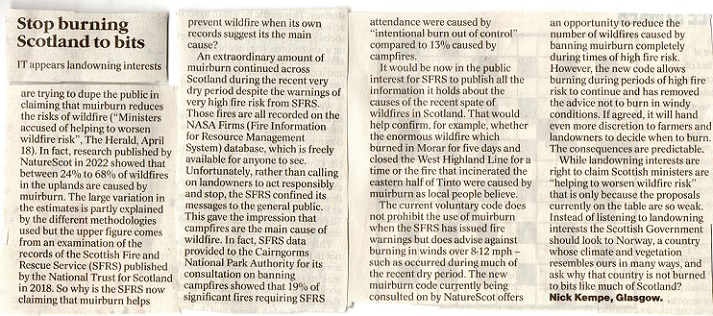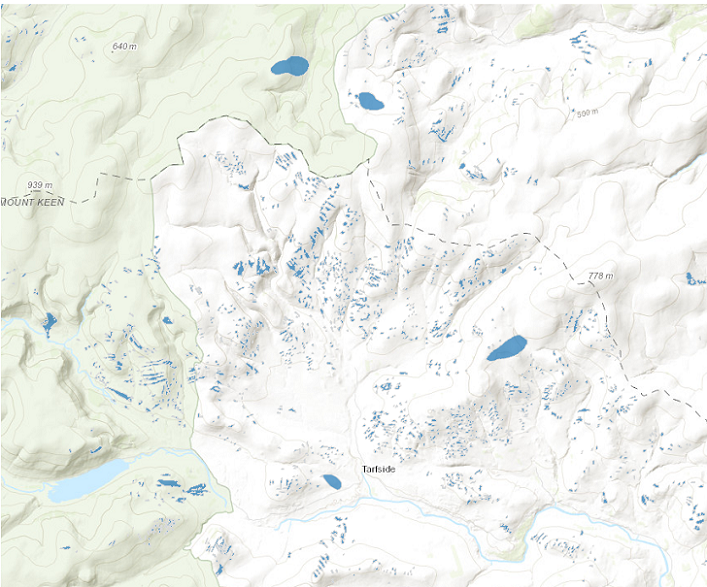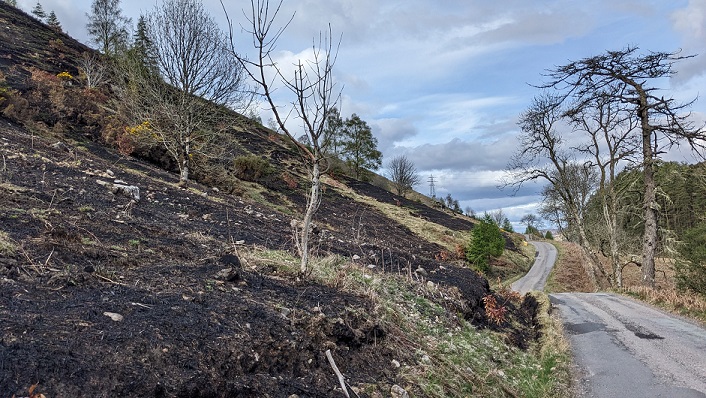
On 18th April landowners and land management interests launched a concerted campaign claiming that rather muirburn being a significant cause of wildfire it was a means of preventing it (see here for BBC coverage). In response I was pleased to have this letter published in the Herald and then when Nan Spowart took up the issues in the Sunday National last weekend (see here). To my mind the most important part of her article is the end where NatureScot and the Scottish Fire and Rescue Service give their response to the issues I have been trying to raise.
NatureScot’s position
“We have been clear that in times of high and extreme fire danger, it is vitally important that the current Muirburn Code is followed in relation to where and when it is appropriate to burn – this includes taking account of the weather, vegetation conditions and nesting birds and only burning when it is safe to do so” (quote from NatureScot spokesperson).
It seems that NatureScot cannot bring themselves to say that there should be no muirburn even in times of very high fire risk. Instead, they refer to the current Muirburn Code which leaves it to the discretion of landowners to decide “where and when” it is safe to do so.
“A licensing scheme for muirburn and the associated new Muirburn Code are being introduced to help ensure that muirburn is carried out safely, appropriately and by trained operators. NatureScot has been working closely with the Muirburn Code Working Group to ensure both are robust and workable.”
The key issue is whether the proposed new Muirburn Code will do more to ensure muirburn is carried out safely and reduce the number of wildfires it causes. Unfortunately, the new code like the old one fails to prohibit muirburn during periods of high fire risk and, worse, removes the provisions in the current advice (which will become statutory):
- not to burn in winds over 8-12mph;
- not to burn on slopes over 27°, increasing this to 45° for everyone (the current code says inexperienced people should not burn over slopes of 18°)
- to limit the width of muirburn strips to 50m to help prevent fires getting out of control
- removes the requirement that a minimum of three people should be on site to control the fire
- etc etc.
The proposed new Code is therefore far from robust and opens the way for landowners and land managers to burn when and what they want (outside areas of peat over 40cm thick).
Since speaking to Nan Spowart about the lack of data on the link between muirburn and wildfires I have discovered that NatureScot has in fact started collecting data on the two (see here), perhaps as a consequence of the research they published in 2022 on muirburn. This data link is not advertised on the NatureScot website, does not come up in searches and has not been advertised as part of their consultation on revising the Muirburn Code. Effectively NatureScot has been hiding from the general public data on muirburn and wildfire which could help show what is really going on.
The available data goes back to 2018 and most of it has been automatically uploaded from satellite records (perhaps from the NASA Firms database). Unfortunately it appears one requires a sign-in code to make proper use of it but the limited data that is available publicly helps show the amount of Scotland that has been subject to muirburn in the last six years – its shocking – and also helps to identify large wildfires that have been caused as a consequence:

Almost all the recorded fires on this extract from the map are on the slopes of hills, rather than the floors of glens. Few are therefore likely to have been caused by campfires, barbecues or bonfires getting out of control and most would appear to show muirburn. The map suggests that much of this has been reasonably controlled but some appears to have resulted in extensive wildfires.
This is not to claim that every larger patch of blue represents muirburn getting out of control, only that likelihood is in this area its the main cause.he size and number of the large blue patches on the online map is far greater in the west than the east of Scotland – despite the west being far wetter. This is because generally gamekeepers on grouse moors in the east carry out muirburn far more carefully than farmers and crofters in the west, some of whom simply empty cans of paraffin onto the land and walk away.

The explanation for this difference is that to graze more livestock you need to clear (burn) as wide an area as possible, whereas to produce more grouse gamekeepers need to produce a patchwork of heather of different ages.
The position of the Scottish Fire and Rescue Service
Michael Humphreys, national wildfire lead for the Scottish Fire and Rescue Service, said:
“Land managers play a critical role in safeguarding communities from the devastating impacts of wildfires. Current evidence does not suggest muirburn causes wildfires. In fact, the muirburn season ends on April 15 each year and we continue to see wildfires into June”.
Logic clearly fails Mr Humphreys, the fact that some wildfires are not caused by muirburn does not mean no wildfires are caused by muirburn, but the way he ignores the evidence is outrageous. You don’t even have to accept any of the evidence from the NatureScot map above or that which I have posted recently on parkswatch showing how muirburn causes wildfires. The research into SFRS’ own records in 2018 published by the National Trust for Scotland (see here) – which was facilitated by SFRS staff – showed that up to c60% of wildfires in Scotland were caused by muirburn. More recently the SFRS also supplied data to the Cairngorms National Park Authority showing that muirburn appeared responsible for more wildfires than campfires (see here)..
Mr Humphreys appears to have betrayed firefighters everywhere and in a decent world he would be forced to resign immediately. Unfortunately, he is more likely to receive a gong for supporting landowning interests. The unhealthy links between senior management interests in SFRS and landowners go back to Mr Humphreys’ predecessor, Bruce Farquharson, who was lauded by Scottish Land and Estates for the way he supported their interests (see here):
“He is universally respected by gamekeepers, farmers, and crofters, and he has made significant strides over the years in formulating productive and conducive working relationships that will make reducing the risk of – and tackling – wildfire more efficient. He has been a stalwart champion of vegetation management techniques like muirburn, which he sees as having a central role in making Scotland’s landscapes more resilient to wildfire”.
Neither NatureScot nor the SFRS are serving the public interest
The quotes in the Sunday National show that the senior management of SFRS, like that of NatureScot, have been so captured by landowning interests that they refuse to see or state the obvious. Muirburn is a significant cause of wildfire in Scotland and deliberately setting fire to the land at times of very high fire risk is completely crazy. In actively supporting landowning interests both organisations hold a high degree of responsibility for the damage muirburn is doing to the natural environment and the amount of carbon its releasing into the atmosphere. They are also actively undermining the intention of the Wildlife Management and Muirburn (Scotland) Act 2024, the intention of which was to limit the damage done by muirburn. SFRS and NatureScot are part of the problem, not the solution.
